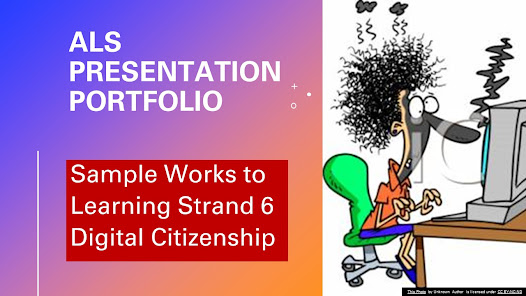Aside from the Activities in the Module or your Assignment/Quizzes, here are sample works that you can include in Learning Strand 6 - Digital Citizenship for your Presentation Portfolio Assessment:
1. Famous Internet Social Networking
Services and Their Uses
YouTube - an American online video sharing and social media platform
owned by Google. It was launched in February 2005 by Steve Chen, Chad Hurley,
and Jawed Karim. It is the second most visited website, with more than one
billion monthly users who collectively watch more than one billion hours of
videos each day.
TWITTER - an American microblogging and social networking
service on which users post and interact with messages known as
"tweets". Registered users can post, like, and retweet tweets, but
unregistered users can only read those that are publicly available. It was created by Jack Dorsey, Noah
Glass, Biz Stone, and Evan Williams in March 2006 and launched in July of that
year.
TIKTOK - known in China as Douyin, is a video-sharing focused social networking
service owned by Chinese company ByteDance. The social media platform is used
to make a variety of short-form videos, from genres like dance, comedy, and
education, that have a duration from fifteen seconds to three minutes.
INSTAGRAM - abbreviated
to IG, Insta or the gram)[9] is an American photo and video sharing social
networking service created by Kevin Systrom and Mike Krieger. Facebook acquired
the service for approximately US$1 billion in cash and stock in April 2012. The
app allows users to upload media that can be edited with filters and organized
by hashtags and geographical tagging. Posts can be shared publicly or with
pre-approved followers. Users can browse other users' content by tags and
locations and view trending content. Users can like photos and follow other
users to add their content to a personal feed.
WhatsApp - an
American freeware, cross-platform centralized instant messaging and
voice-over-IP service owned by Facebook, Inc. It allows users to send text
messages and voice messages, make voice and video calls, and share images,
documents, user locations, and other content.
WeChat - a
Chinese multi-purpose messaging, social media and mobile payment app developed
by Tencent. First released in 2011, it became the world's largest standalone
mobile app in 2018, with over 1 billion monthly active users.
Qzone - a social networking website based in China which was created by Tencent in 2005. It allows users to write blogs, keep diaries, send photos, listen to music, and watch videos.
TUMBLR - an
American microblogging and social networking website founded by David Karp in
2007 and currently owned by Automattic. The service allows users to post
multimedia and other content to a short-form blog. Users can follow other
users' blogs. Bloggers can also make their blogs private.
LinkedIn is an American business and employment-oriented online service that
operates via websites and mobile apps. Launched on May 5, 2003, the platform is
mainly used for professional networking and allows job seekers to post their
CVs and employers to post jobs.
(Source: Wikipedia)
2. Functions of the Different Parts of a Microcomputer and its Peripherals
Draw this is an A4 bond paper or A4 size illustration board. Color the parts.
1. Monitor - is an output device that displays information in pictorial form. A monitor usually comprises the visual display, circuitry, casing, and power supply.
2. A modulator-demodulator, or simply a modem, is a hardware device that converts data from a digital format, intended for communication directly between devices with specialized wiring, into one suitable for a transmission medium such as telephone lines or radio.
3. System unit - also known as a computer chassis, tower, or cabinet, is the enclosure that contains most of the components of a personal computer. Cases are usually constructed from steel, aluminum, and plastic.
4. Mouse - a hand-held pointing device that detects two-dimensional motion relative to a surface. This motion is typically translated into the motion of a pointer on a display, which allows a smooth control of the graphical user interface of a computer.
5. Speaker - an output hardware device that connects to a computer to generate sound. The signal used to produce the sound that comes from a computer speaker is created by the computer's sound card.
6. Printer - a peripheral machine that makes a persistent representation of graphics or text, usually on paper. While most output is human-readable, bar code printers are an example of expanded use for printers.
7. Keyboard - a peripheral input device modeled after the typewriter keyboard which uses an arrangement of buttons or keys to act as mechanical levers or electronic switches.
3. Survey the number and types of vehicles passing your barangay road, tabulate, and graph the data using Microsoft Excel














